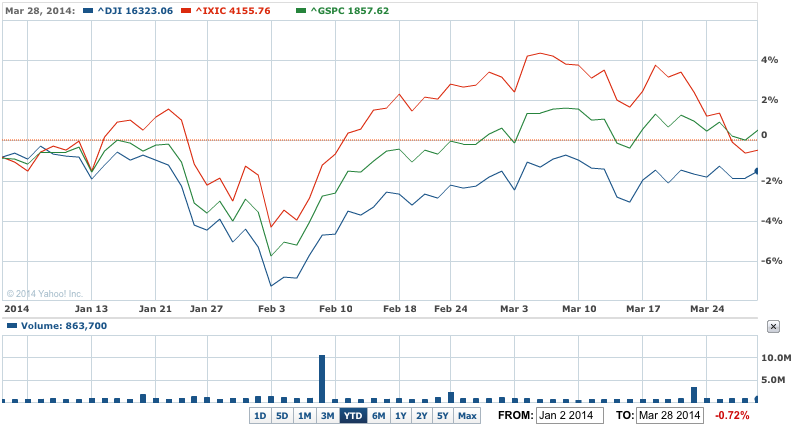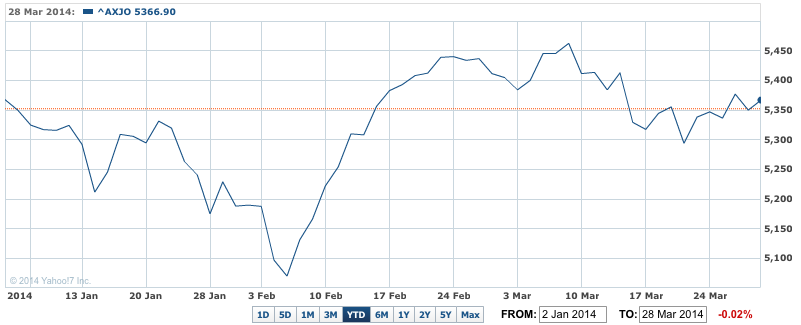Most sharemarkets ended March on an up note in what some analysts said was a bout of window dressing (designed to lift prices and indexes and produce more fees for managers).
The Aussie dollar ended trading offshore at 92.72 US cents – up around 3.9% over the quarter. The Kiwi dollar also rose against the US currency in the quarter as interest rates rose and the economy boomed.
Iron ore jumped 4% overnight to $US116 a tonne. The key commodity for Australia is down around 10% for the quarter.
But gold and oil rose over the three months to March.
In New York the Standard & Poor’s 500 index ended the quarter trading up 8.40 points, or 0.5%, at 1,872.33, and 0.7% gain for the month.
The benchmark index for US and the globe rose 1.3% over the quarter – thanks to rises of more than 3% in February and the smaller gain last month. Those rises helped offset the 3.3% slump in January.
The Nasdaq Composite finished the day up 43.24 points, or 1% at 4,198.99 (some window dressing there perhaps?), but lost 2.5% over the month as investors sold out of biotechs and big cap tech shares.
The Nasdaq still managed a gain of half a per cent over the quarter and the market and its plethora of tech stocks remain the ones to watch.
The Dow jumped 134.60 points, or 0.8%, at 16,457.66 and was up 0.8% for the month. However, the blue-chip index lost 0.7% over the quarter. It was the Dow’s first fall in five quarters.
Monday’s gain came on bullish comments from Fed chair, Janet Yellen who indicated the central bank was still watching the unemployment rate.
US markets rise on last day of lackluster quarter

Focus is now switching to the US first quarter reports due to start next week. Watch for those results from the big Wall Street banks, as we have been reporting for the past couple of weeks.
In Europe the Stoxx Europe 600 Index added 0.2% overnight, to trim the fall for the month to 1.1%. That still left the index up 1.8% for the quarter.
Lower than expected inflation last month (0.5% not the 0.6% expected) failed to have an impact on market sentiment, although some analysts see the European Central Bank referring to the rising chance of deflation at its meeting on Thursday.
London’s FTSE 100 index fell 0.3% overnight, 3.1% in March and 2.2% for the quarter. That was despite improving economic growth and falling unemployment.
In Asia, The MSCI Asia Pacific Index added 0.8% yesterday, but was down 0.1% for March and 2.6% for the year so far as big losses on the Tokyo market drove the index lower.
Tokyo’s Nikkei 225 rose 0.9% to a three-week high on Monday, but that still left it 9% lower over the quarter. Japanese industrial production surprisingly fell in January. Later today more data on business confidence will be released.
The Shanghai Composite Index lost 3.7% over the quarter, and confidence will be further tested later today by the release of the two monthly surveys of manufacturing activity.
But emerging markets, Indonesia and the Philippines enjoyed healthy gains, up 11.6% and 8.7% respectively, with investors moving back into these markets after heavy selling last year. Emerging markets overall steadied in the quarter and rose strongly in the final weeks of March.
In Australia, the ASX 200 rose 0.1% over March and the All Ords ended up less than 0.1%.
The ASX 200 rose 0.5% over the quarter, which is also better than the nasty drop at the start of the year in January.
ASX 200 recovers for flat start to 2014

The big drivers in March here were Commonwealth Bank of Australia which rose 4% to $77.44 while Westpac rose 3.9% to $34.56.
The ANZ was up 3.7% to $33.06, and National Australia Bank added 2.7% to $35.46.
BHP Billiton fell 2.7% to $36.47 in March while Rio Tinto lost 3.6% to $63.55.
Woolworths fell 0.4% to $35.72, Wesfarmers, owner of Coles, lost 3.6% to $41.19 but like the wider market, Telstra Corporation was flat at $5.08.
Childcare network G8 Education was the top-performing stock in the ASX 200 for the quarter, climbing 22.2%.













